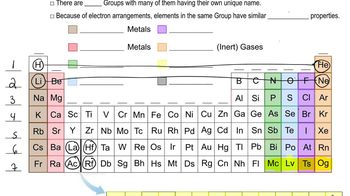Fill in the gaps in the following table: Symbol 133Cs+ Protons 35 15 Neutrons 46 16 30 Electrons 18 20 Net charge 1- 5+
Using the periodic table, predict the charge of the most stable ion of the following elements: (e) Sb.
 Verified step by step guidance
Verified step by step guidance
Verified video answer for a similar problem:
Key Concepts
Periodic Table and Group Trends

Ion Formation and Charge

Stability of Ions

Each of the following elements is capable of forming an ion in chemical reactions. By referring to the periodic table, predict the charge of the most stable ion of each: (a) Be (b) Rb (c) As (d) In (e) At.
Using the periodic table, predict the charge of the most stable ion of the following elements: (a) Li (b) Ba (c) Po (d) I
Using the periodic table to guide you, predict the chemical formula and name of the compound formed by the following elements: (a) Ga and F (b) Li and H
Using the periodic table to guide you, predict the chemical formula and name of the compound formed by the following elements: (c) Al and I
Using the periodic table to guide you, predict the chemical formula and name of the compound formed by the following elements: (d) K and S.
